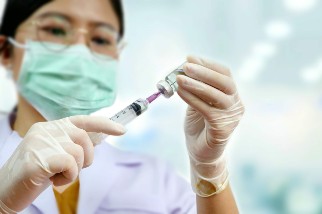Hospital-based healthcare personnel experience approximately 385,000 needlestick/sharp injuries each year, according to CDC. As thousands of Americans receive the COVID-19 vaccine every day, those involved in administering the vaccinations can take several steps to prevent needlestick injuries.
needlestick/sharp injuries each year, according to CDC. As thousands of Americans receive the COVID-19 vaccine every day, those involved in administering the vaccinations can take several steps to prevent needlestick injuries.
New CDC guidance outlines safety measures to reduce the probability of needlestick injuries and exposure to bloodborne pathogens. Employers are encouraged to train vaccinators on OSHA’s bloodborne pathogen standard, the definition of a needlestick injury, properly wearing and removing PPE, disposing of sharps and reporting needlestick injuries.
Employers should also confirm vaccinators are up-to-date on their hepatitis B vaccinations, and provide vaccinators with the proper PPE, sharps with engineered safety devices and proper disposal containers. It’s also important to follow CDC and OSHA guidance on measures such as physical distancing to prevent the spread of COVID-19, and follow cleaning and disinfecting protocols between appointments.
Vaccinators should complete required training, follow proper hand hygiene, wear necessary PPE, not recap syringes without safety devices and report any needlestick hazards they observe to the site supervisor.
The guidance also outlines steps for safe sharp disposal, including:
- Use needles with engineered sharps injury protections (safety devices).
- Do not recap, shear or disassemble syringes.
- Place sharps containers within arm’s reach at a height convenient to the vaccinator and dispose of contaminated sharps immediately into these containers.
- Use sharps containers that are closable, puncture-resistant, crush-resistant, leak-proof, color coded, labeled to warn of hazardous waste and clearly marked with a line that indicates when the container is considered full.
- Replace sharps containers when they reach the full line as directed by the manufacturer.
Related Links
Building Toward Herd Immunity – Article
COVID-19: A Look Ahead for 2021 – Article
CDC Publishes COVID-19 Vaccination Communication Toolkit – Article
OSHA Issues Stronger Workplace Guidance on Coronavirus – Article